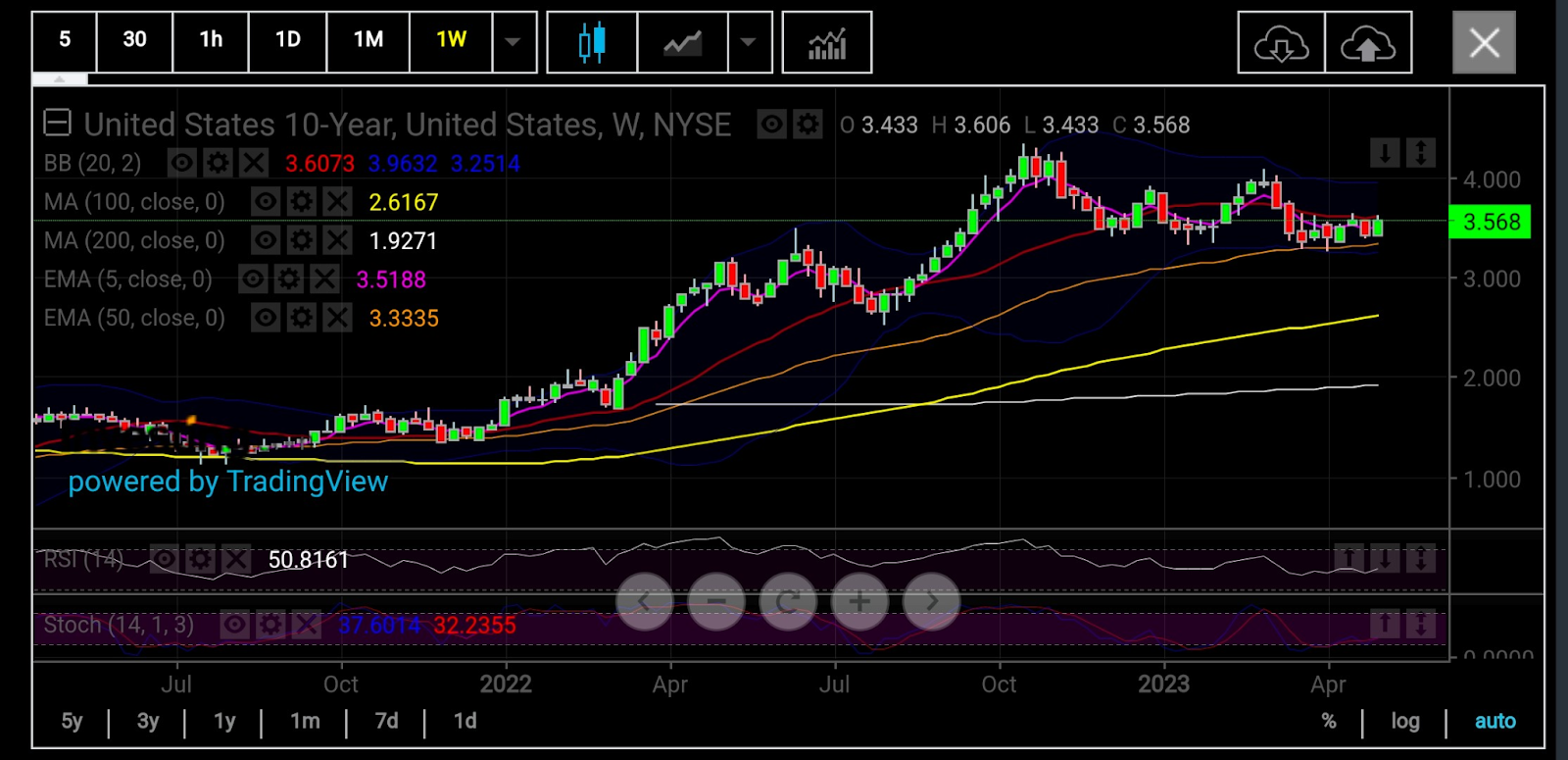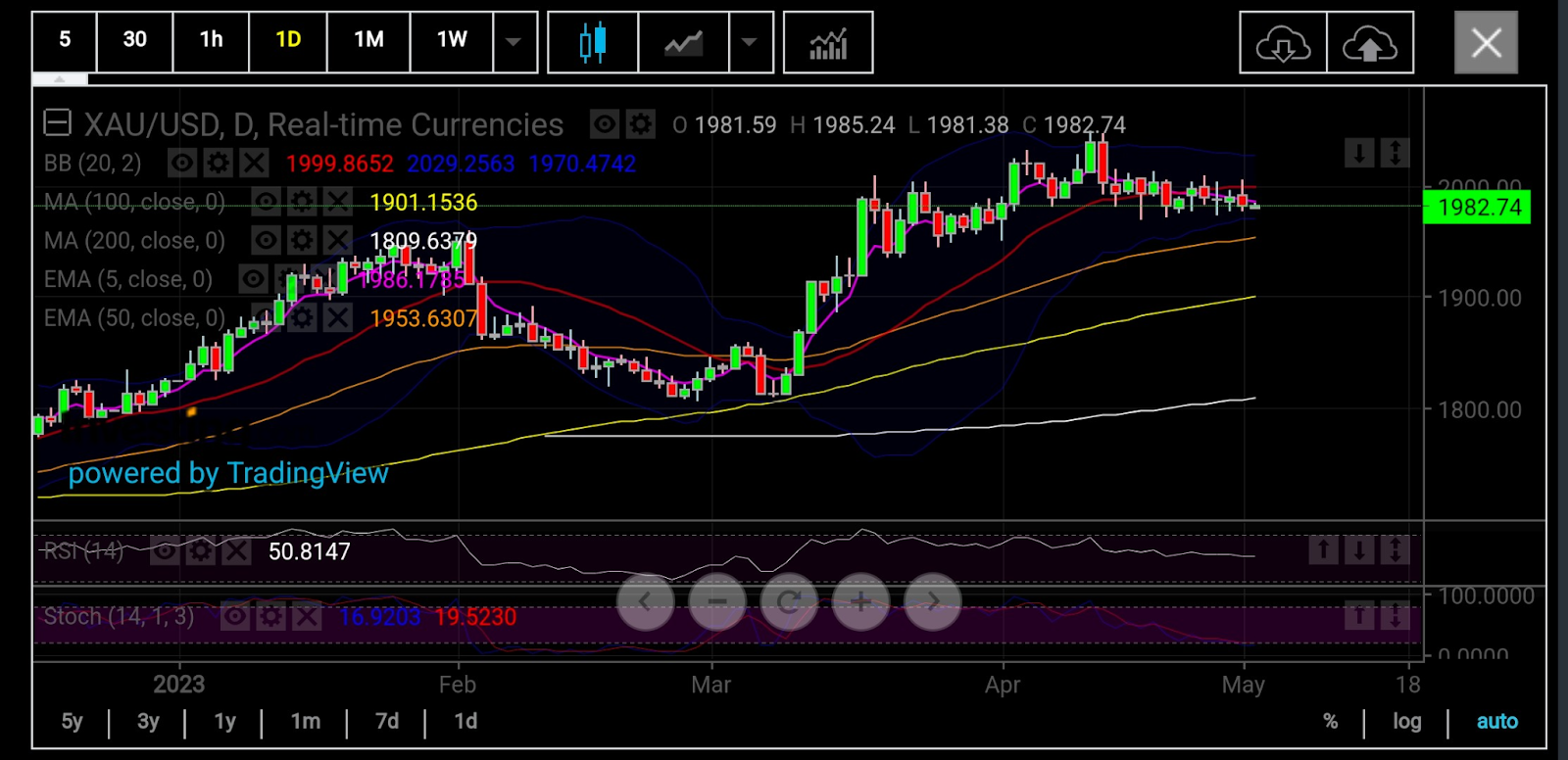- Speculation is growing about the Fed's decision on halting rate hikes, with a potential pause in June
- The Fed's upcoming FOMC meeting will be closely watched for signals of future policy actions
- The impact of the Fed's decision on the dollar and Treasuries will be important catalysts for moves across markets, including in commodities like gold and oil
The noose is tightening around Jay Powell and his coterie of policy-makers to make a decision on when to halt the more than a year of rate hikes by the Federal Reserve. And Wednesday’s meeting of the central bank’s Federal Market Open Market Committee, or FOMC, might begin revealing what every market — from the dollar to Treasuries, equities and commodities — has been waiting for.
While chatter on a rate hike pause has been around for months, a Wall Street Journal piece took the conversation to a viral level this week by suggesting that the Fed’s tightening campaign which began 15 months ago will probably be suspended by June. That will be after the likely addition of another quarter point on May 3 that brings rates to a peak of 5.25% from just 0.25% at the onset of the pandemic.
As Nick Timiraos, the Journal’s chief economics correspondent, points out, how closer the Fed is to its endgame on rates will probably be known after this FOMC meeting because officials think their communications around future policy actions can be as significant as individual rate changes.
“Until now, the Fed has been looking for clear signs of a slowdown and easing inflation to justify a pause,” Timiraos said in a tweet. “But after this week, the calculations could flip. Officials could need to see signs of stronger-than-expected demand and inflation to keep hiking.”
For economists, traders, fund strategists and Fed beat reporters that means reading deeper than usual into the central bank’s standard post-meeting communique that announces the rate decision, along with the terse sentence or two about near-term policy direction. It will also mean taking a more critical look at Fed’s latest economic projections and dot plot charting. Last but not least, it will mean analyzing in real-time what dribbles from Powell’s mouth at the news conference that follows the FOMC meeting.
While such audience engagement is standard fare at each Fed rate decision, the appetite for what the central bank says this time could be multifold higher due to growing speculation of a Fed pivot.
Context
To fight inflation, the Fed has added 475 basis points to rates in nine increases since March 2022.
Inflation itself, as measured by the Fed’s favorite price indicator — the Personal Consumption Expenditure, or PCE, Index — grew by just 4.2% in the year to March this year from a four-decade high of 6.6% in the 12 months to March 2022.
Despite the cooling in prices, annual inflation remains at more than double the Fed’s 2% target. The central bank has, thus, embraced rate hikes as the only proven way to fight the upward trajectory in prices.
Fed officials and markets, however, remain at odds over the future path of interest rates, with the central bank expecting interest rates to remain around current levels through 2023 and investors betting on rate cuts before the year’s end.
Given renewed signs of stress in the US banking sector in recent days, with problems at First Republic Bank, some think Fed officials may signal a pause in June.
Some Fed policymakers have indicated that the tighter credit conditions could act like an additional rate hike, possibly reducing the number of hikes necessary to bring inflation back down to its target.
US data of late has reinforced investor worries about a slowing economy.
The Commerce Department reported on Thursday that real gross domestic product, or GDP, grew at an annual rate of 1.1% in the first quarter of 2023 versus the 2.6% expansion in the fourth quarter of 2022. Economists tracked by Investing.com had expected a GDP growth of 2% for the first quarter.
What This Means for Commodities
For my own audience, the Fed’s actions and how they will impact gold, oil and other key commodities will be what matters.
My key collaborator on commodity technicals, Sunil Kumar Dixit of SKCharting.com, is joining me for this task. But before we get to even analyzing the outcome of a Fed pause on commodities, we need to figure out the likely impact first on the dollar and Treasuries as these will be the catalysts for moves across markets, including in raw materials such as crude oil and gold.
Charts by SKCharting.com, with data powered by Investing.com
Dollar Index
Action on the Dollar Index indicates that a short term support base has formed at 101.50, which, if broken, can extend the drop to the important support at the 100-week Simple Moving Average, or SMA, of 100.67. Dollar bulls will try harder to defend this zone which is the acceleration point for a deeper correction into the 50-month Exponential Moving Average, or EMA, of 98.90.
The widely-anticipated Fed rate hike on May 3 could first open a broader upward trading range in the dollar, before any move lower.
If dollar bulls succeed in defending the major 101.50 level, especially at 100.68, a consolidation above 102 will eventually extend the upward move towards the 50-day EMA of 102.34, followed by the weekly Middle Bollinger Band of 102.82. If these two are cleared, they can strengthen demand in the dollar till the 50-week EMA of 103.50.
One caveat for any upward move in the dollar — it is important to watch closely how traders react to the 102.34 resistance. If this is not cleared, downside bias will prevail.
Treasuries
Yields on the 10-year US Treasuries have been ranging between the weekly Middle Bollinger Band of 3.60 and the 50-week EMA of 3.30. The latter is particularly counted on for its strong support base.
Weakness in yields (which may not happen in the immediate future) will likely be visible only on a break below 3.30. In this event, the next support will be seen at the monthly Middle Bollinger Band of 2.92.
Fed's rate hike announcement on Wednesday can initially cause a break above the 3.60 resistance, pushing it towards 3.80.
Signals of a rate hike pause from June onwards will act as a dampener for yields, returning them to the 3.30 base, followed by a drop lower over time.
Gold
The spot price of gold moves to the beat of inflation and related economic overtures. For the purpose of this article, we’ll focus on just the technical aspect. On this ground, spot gold has over the past week returned under the thumb of the bears, evidenced by Monday’s rejection from the $2,006-an ounce high and failure to break above previous week's peak of $2,009.50.
A Fed hike of 25 basis points for May can still cause some sideways volatility in the yellow metal though.
A break below the previous week's low of $1,973 will likely extend the drop to $1,963 and the 50-day EMA of $1,953.
But indication of a Fed pause from June could send gold into new volatile territory.
In this event, consolidation above the $1,980 support — followed by strong acceptance above $1,991 — can help gold accumulate gains toward the $1,998-$2,003 resistance zone.
Resumption of an uptrend in gold will require strong energy to advance above this zone. Clearing through $2,010 will add affirmation to the uptrend, targeting a retest of spot gold’s recent $2,048 peak.
Overall, as long as prices sustain below the $2010 turning point, bears will remain in control, eyeing the 50-day EMA of $1,953.
Oil
Oil prices, like those of gold, are determined by various supply-demand factors from the consumption of gasoline, diesel and jet fuel to the inventories of crude stored in the United States and across the world. How much top oil importer China buys and whether OPEC+ is honestly implementing the production cuts it pledged or just getting a ride from high prices also goes into the equation. For the purposes of this analysis, we’ll just focus on the technicals.
As of Monday, the downward bleeding in WTI, which began from an $83.50 high, had not been fully staunched, even after the filling of its gap up open of $75.70 from April 3 triggered by OPEC+’s latest production maneuver. At the time of writing, the U.S. crude benchmark was up 0.5% at $76.03.
The downtrend is guarded by immediate resistance, which is a heavy-weight confluence of 50 Day EMA and 100 Day SMA, both at $77.00
Weekly stochastics at 58/64, as well as RSI at 46 below neutrality of 50, favor continuation of a bearish correction extending to $73.80, followed by $71.80. Even a revisit to the 200-week SMA of $67 cannot be ruled out, notwithstanding supportive supply-demand.
Consolidation above 5 Day EMA $75.95 can lead to a short term upward move towards $77.
If WTI gets enough trigger for upward mobility, a sustained break above $77 will witness further recovery towards the daily Middle Bollinger Band of $79.
***
Disclaimer: The content of this article is purely to educate and inform and does not in any way represent an inducement or recommendation to buy or sell any commodity or its related securities. The author Barani Krishnan does not hold a position in the commodities and securities he writes about. He typically uses a range of views outside his own to bring diversity to his analysis of any market. For neutrality, he sometimes presents contrarian views and market variables.
